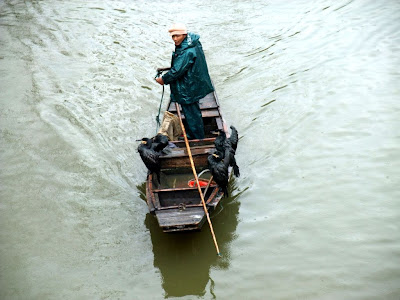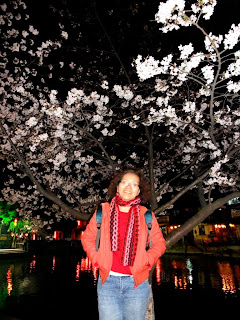
Xitang (西塘), situated at North Jiashan of Zhejiang Province, is an ancient water town of more than 2000 years with history dated back to Chinese Spring and Autumn Period when it was first located at the border of Yue and Wu States. The canals were actually dug out for military purposes by General Wu-Zixu at that period. The place was slowly turned into a trade center in Yuan Dynasty and during Ming Dynasty, it became a business town as many traders flocked in from Anhui Province and settled down. It was already quite a popular place in Qing Dynasty. Many of its river piers and quays were built then. Cobbled streets, old buildings, bridges arching over canals, Xitang is a town of unique glamor, twists and tune, remote and mysterious.


Compare to other parts, this session do not have a rustic feeling as large area had been retouched for tourists


Rowing boats lingering on the river under the shade of peach blossom trees.


There are nine canals crisis-crossing and stretching across eight sections, linked by old fashioned bridges.


Boats propelling under rain


The town was flourished with cherry blossom in Spring.



To experience a quiet side of Chinese life and a true place for a break of stresses, come to Xitang.


River quay for boats boarding.


Ancient life in our reality environment.




I was waiting for a boat ride.



Hundreds years old houses still serve as homes to the locals.





Life here is calm and easy, full of comfort and peace, little difference from lifestyle of their ancestors thousands years ago.




A boat restaurant






Xitang keeps a tranquil and scenic beauty which frequently depicted in Chinese landscape painting.






The covered walkway which was romantically named as lingering form rain corridor of misty rain has a length of 1000 meters.





The 104 bridges arching over canals were built in varying styles spanning the Ming and Qing Dynasty. These bridges make Xitang very special in look.


This bridge appears like a rainbow and there is one looking like a flute.


Buildings were set along the banks of canals as it was the main way of transportation connecting through the areas. Architecture of the buildings were greatly influenced by Anhui style of Ming Dynasty.




The only man in Xitang who used cormorants to catch fish. He and his father had been basing on this technique for earning a living for 80 years. He now focus on making tourists money rather than actual fishing. Taking a picture with him and his cormorants was chargeable at about rmb25-30.00




It was said that it's lucky if you meet rain in Xitang. The fresh air and light fog will follow after rain especially in the morning, that offers a different look and feel of Xitang.




Xitang is a world away particularly for people from modern world.


Houses, trees, flowers, bridges, stone lane and river water are harmoniously integrated.



It was like a piece of landscape painting.





A completely different world from hustling and bustling world.


Artistically designed restaurant along the rain corridor.


The rain corridor acts as an outer of buildings and giving shade to visitors while raining.





Some antique residences with old tiled roofs .


Xitang was the place featured in the final sequences of motion picture Mission Impossible III.


The local snacks including fruits "wulu" and tiny little rice dumplings "yi-kou zhong".


The pork knuckle, the fermented rice soup (to keep body warm), the pepper salt fried pumpkin and the little fish (Pangpi Yu) are all its local delicacies.



The wooden recycling dustbin and one of its olden residential house.


This is the place in China where you still can find peace of mind.




Xitang still is inspired by most artists as it has not lost its initial charm like many water villages in China.


The bar street.


The quiet lanes, long or short, wide or narrow, paved with stone planks, with tall and stained walls were polished by feet of pedestrians as well as years of weathering. They are exactly like a history tunnels of Xitang. Xitang has 122 small lanes (longtang). The longest lane with length of 68 meter and width less than one meter, located at West Street, is named Shipi Lane.





Xitang at night.










At dusk, canals were lighted up with romantic red lanterns.



Light illuminated Cherry flowers.






A sight from our hotel room window.


Our room was facilitated with a wooden ancient bed with an old tea table setting besides it. Its cherry shaped windows are beautiful.



No comments:
Post a Comment